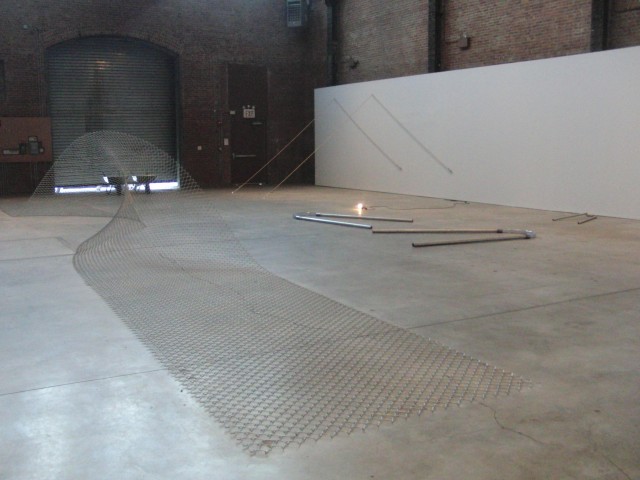
Extremely satisfying and necessary Bill Bollinger retrospective runs through July 30 at SculptureCenter (photo by twi-ny/mdr)
SculptureCenter
44-19 Purves St., Long Island City
Thursday – Monday through July 30, $5, 11:00 am – 6:00 pm
718-361-1750
sculpture-center.org
bill bollinger slideshow
“I only do what it is necessary to do,” Brooklyn-born sculptor Bill Bollinger said in 1968. “There is no reason to use color, to polish, to bend, to weld, if it is not necessary to do so.” Bollinger, who died of alcoholism in 1988 at the age of forty-eight, is the subject of a small but fascinating retrospective at SculptureCenter in Long Island City. Concentrating on his most productive years of the late 1960s, the two-floor show consists of many works that repurpose standard industrial supplies, emphasizing space, form, and materiality. Using wheelbarrows, lightbulbs, Manila rope, plastic hoses, electric cables, aluminum pipes, and sections of Cyclone fencing, Bollinger created a conceptual oeuvre that brought together art and commodity in unique ways; indeed, sometimes you have to look twice before realizing what is part of the show and what is merely part of SculptureCenter’s former-factory home. But that is not meant to detract one iota from Bollinger’s extremely satisfying work, particularly “Cyclone Fence,” a gently, beautifully twisted chain-link fence that rises from the floor as if it’s alive, and “Graphite Piece,” in which black graphite powder has been thrown against a wall in its own room. A contemporary of such more well known artists as Richard Serra, Eva Hesse, Bruce Nauman, Dan Flavin, Carl Andre, Donald Judd, and Robert Smithson, Bollinger participated in several important and influential group shows in the late 1960s, as well as having his own solo exhibition at the Starrett-Lehigh Building in 1970, before personal problems, including a custody battle for his son that he ultimately won, sent him upstate into relative obscurity. The show is supplemented with a series of drawings upstairs as well as preparatory sketches, notes, and letters downstairs that reveal Bollinger’s detailed creative process. The retrospective also includes Bollinger’s only known film, in which he tries to balance what appears to be a telephone pole on the ground, only to knock it over once he does so, toying with the viewer’s expectations. “It is all very easy to execute, does not exist until it has been executed, ceases to exist when it has been taken down,” he once explained. “Bill Bollinger: The Retrospective” offers a much-needed, well-curated look at an important twentieth-century artist whose history had been threatening to cease to exist.